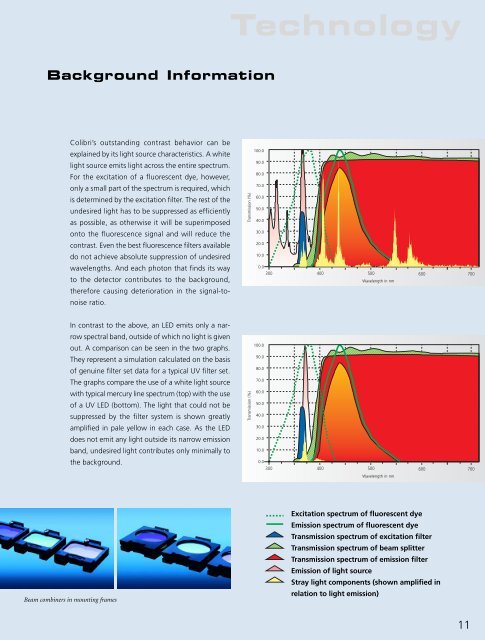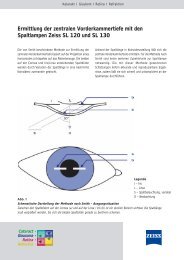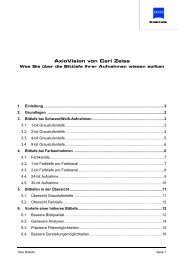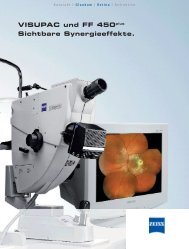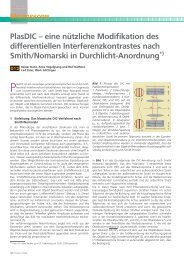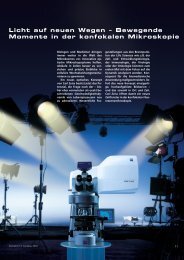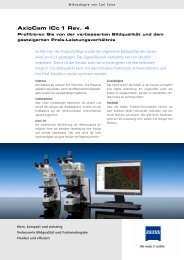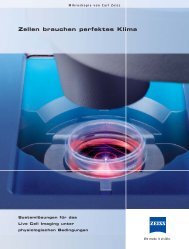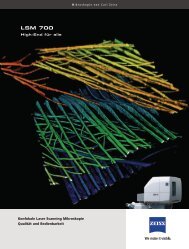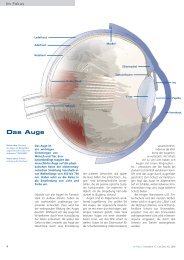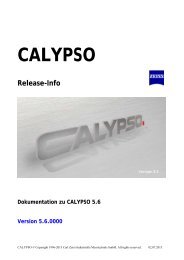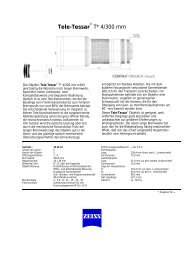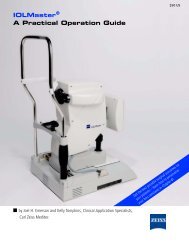Colibri - Carl Zeiss
Colibri - Carl Zeiss
Colibri - Carl Zeiss
You also want an ePaper? Increase the reach of your titles
YUMPU automatically turns print PDFs into web optimized ePapers that Google loves.
Background Information<br />
<strong>Colibri</strong>’s outstanding contrast behavior can be<br />
explained by its light source characteristics. A white<br />
light source emits light across the entire spectrum.<br />
For the excitation of a fluorescent dye, however,<br />
only a small part of the spectrum is required, which<br />
is determined by the excitation filter. The rest of the<br />
undesired light has to be suppressed as efficiently<br />
as possible, as otherwise it will be superimposed<br />
onto the fluorescence signal and will reduce the<br />
contrast. Even the best fluorescence filters available<br />
do not achieve absolute suppression of undesired<br />
wavelengths. And each photon that finds its way<br />
to the detector contributes to the background,<br />
therefore causing deterioration in the signal-tonoise<br />
ratio.<br />
In contrast to the above, an LED emits only a narrow<br />
spectral band, outside of which no light is given<br />
out. A comparison can be seen in the two graphs.<br />
They represent a simulation calculated on the basis<br />
of genuine filter set data for a typical UV filter set.<br />
The graphs compare the use of a white light source<br />
with typical mercury line spectrum (top) with the use<br />
of a UV LED (bottom). The light that could not be<br />
suppressed by the filter system is shown greatly<br />
amplified in pale yellow in each case. As the LED<br />
does not emit any light outside its narrow emission<br />
band, undesired light contributes only minimally to<br />
the background.<br />
Beam combiners in mounting frames<br />
Technology<br />
Transmission (%)<br />
Transmission (%)<br />
100.0<br />
90.0<br />
80.0<br />
70.0<br />
60.0<br />
50.0<br />
40.0<br />
30.0<br />
20.0<br />
10.0<br />
0.0<br />
300 400 500<br />
Wavelength in nm<br />
600 700<br />
100.0<br />
90.0<br />
80.0<br />
70.0<br />
60.0<br />
50.0<br />
40.0<br />
30.0<br />
20.0<br />
10.0<br />
0.0<br />
300 400 500<br />
Wavelength in nm<br />
600 700<br />
Excitation spectrum of fluorescent dye<br />
Emission spectrum of fluorescent dye<br />
Transmission spectrum of excitation filter<br />
Transmission spectrum of beam splitter<br />
Transmission spectrum of emission filter<br />
Emission of light source<br />
Stray light components (shown amplified in<br />
relation to light emission)<br />
11


